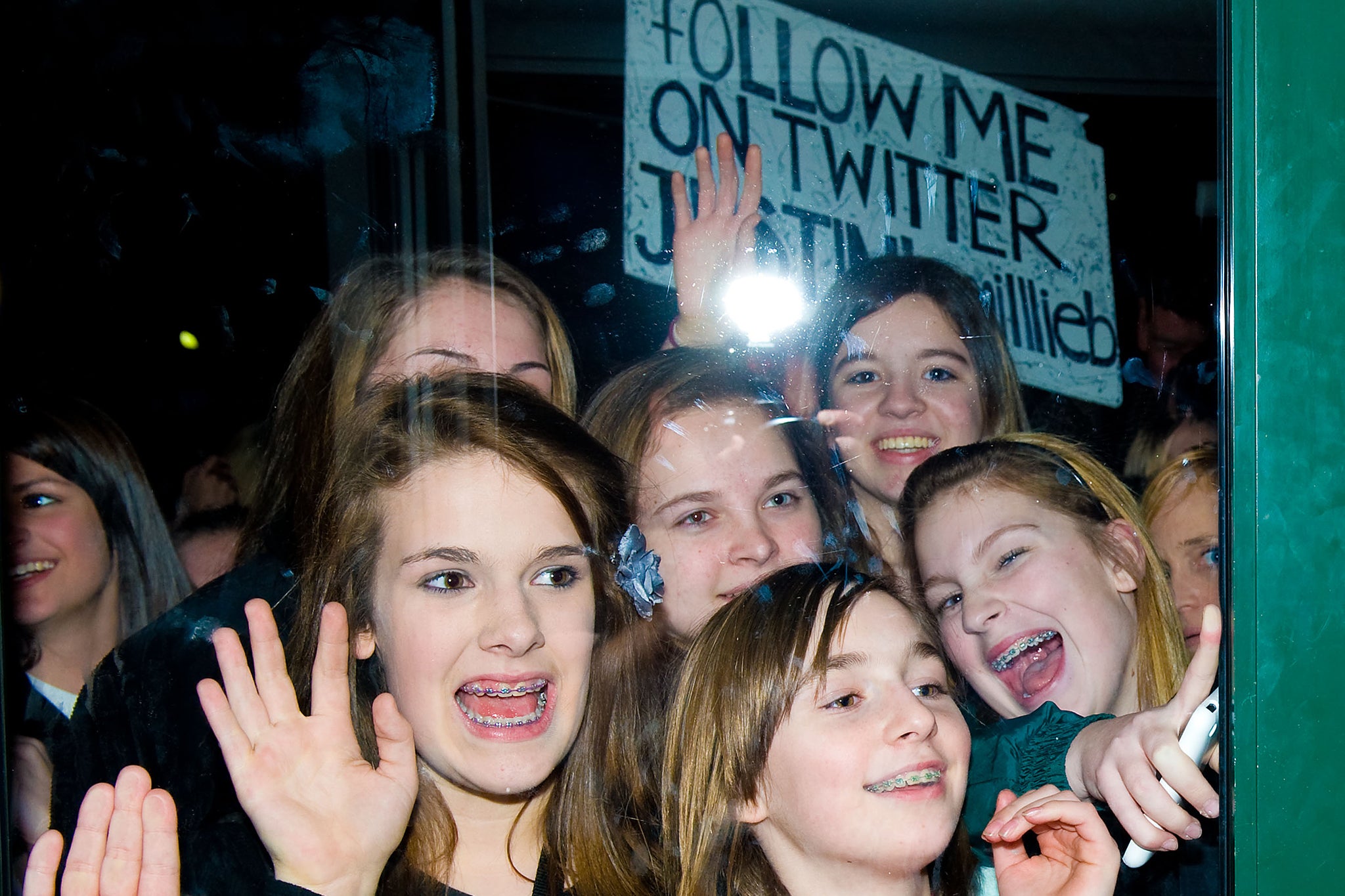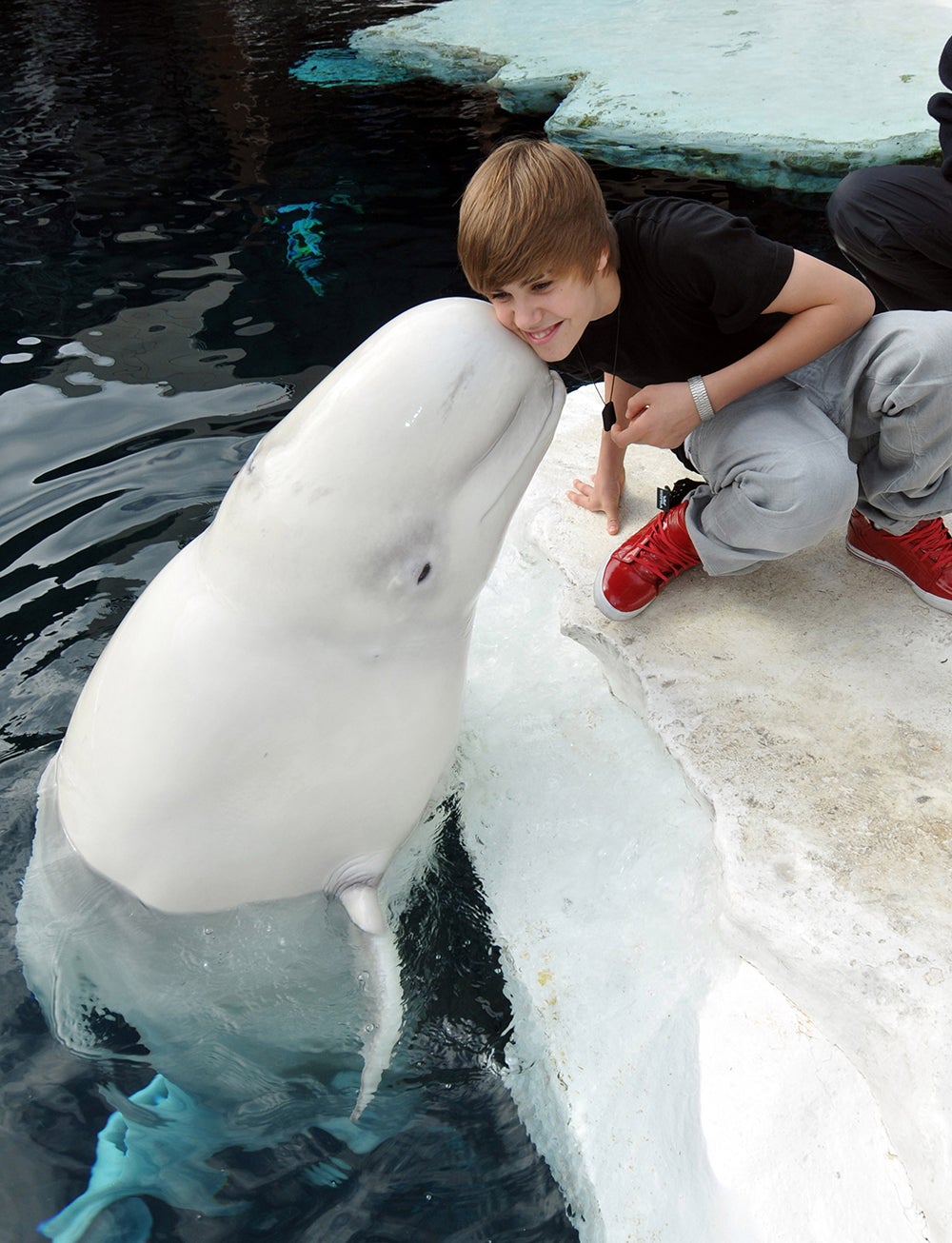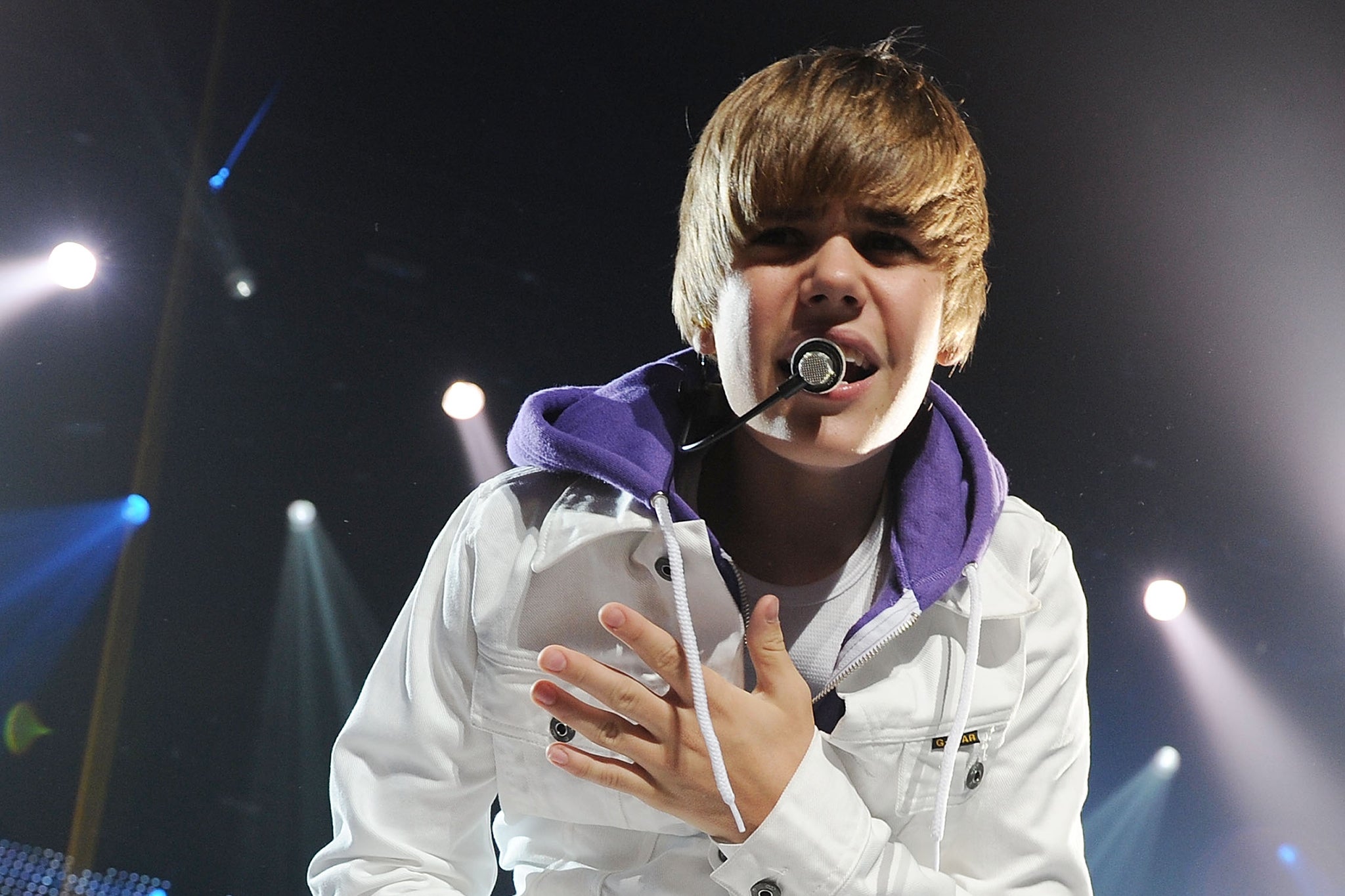Nearly 20 years on, the videos look like grainy real-life footage from the seconds before a dream comes true. A Canadian boy in his early teens named Justin Bieber, his fringe flicked like a perfect heartthrob-in-training, wanders a bedroom sporting Bart Simpson and Tupac posters, singing Chris Brown’s “With You”. Now here he is idling nervously at a microphone in a school hall, clad in a shirt and tie, awaiting the first notes of Ne-Yo’s “So Sick” from a CD player. Or busking with a guitar on the steps of his local train station in Stratford, Ontario – trying to raise money for a trip to Disney World – as loiterers chatter or chow down on sandwiches along to his cherubic soul warbles.
The accompanying notes from his mother Pattie Mallette, too, sound so politely hopeful in their ambition to use the new possibilities of the internet to turn her son into a star. “Justin made it to the final three in the local singing competition,” reads one; “Justin singing ‘Cry Me a River’ by Justin Timberlake,” reads another, with the helpful clarification, “Justin Bieber (sounds like Beeber).” The irony simply squeals out of the screen that these train station loungers and pushy talent show parents – even the then 13-year-old artist himself – have no idea that Bieber would soon become a phenomenon; the world’s first YouTube pop sensation and global teen superstar, boasting professional relationships with Usher, Frank Ocean and Ludacris and a 4 million-selling US Number One debut album My World 2.0, released 15 years ago last month.
“There was a vacancy in the industry at that time for a cute, young male artist for every girl to fall in love with, and for every boy to emulate,” says “Mama Jan” Smith, the singer and producer who was hired as Bieber’s vocal coach in 2008 ahead of his first major tour. She cites a lineage from Elvis through Michael Jackson and Timberlake to Bieber’s breakthrough. “He filled that moment in time and in history. It was the collision of his true talent with technology and timing.”
In the late 2000s, a pop world dominated by global TV star-searches such as The X Factor and America’s Got Talent had yet to tire of an overnight obscurity-to-superstar story. Now here was a new-tech twist. In 2008, Atlanta mover and shaker Scooter Braun (now infamous for his high-profile dispute with Taylor Swift over ownership of her album masters) was trying to find clips of a different singer when he accidentally clicked on Mallette’s video of Bieber singing Ne-Yo at the talent show. Impressed, he tracked the teenager down by contacting the theatre in the video and his school, eventually finding Mallette and convincing her to fly Bieber to Atlanta to record demos with Usher. But not before encouraging the young singer to continue building his YouTube fanbase. “I said: ‘Justin, sing like there’s no one in the room. But let’s not use expensive cameras’,” Braun told the New York Times in 2009. “We’ll give it to kids, let them do the work, so that they feel like it’s theirs.”
Bieber’s videos were already beginning to gain traction. “I had a hundred views, then a thousand views, then 10,000 views, so I just kept posting more videos and more videos,” he later told Good Morning America. A bidding war to sign the teenager was soon underway between Usher and Timberlake. Usher won (two megastar Justins in one deal was considered too confusing for pop fans), and united with Braun to form their own label Raymond Braun Media Group (RBMG) to manage Bieber’s career. Usher introduced him to the press as a “young phenomenon”, and sold him to fans as the epitome of the millennial teen dream, but with an aspirational undercurrent of encroaching maturity that was likely to strike a chord with a generation being web-sped towards adulthood. His 2009 debut single “One Time”, for example, was an adorable puppy love song slathered in clubland R&B beats; its video featured Bieber taking over Usher’s mansion for a rebellious skateboards-by-the-pool party, like Home Alone crossed with a butter-wouldn’t-melt Animal House.
It worked. Bieber Fever swept the world’s stream-era fangirls, soon dubbed Beliebers. With the swift emergence of debut EP My World, rushed out of his first sessions to catch the wave, the teenager charted in 14 countries and became the first artist ever to have seven songs hit the Billboard 200 from a debut release. His appearances at shopping mall performances were swamped with adoring fans, and he soon overtook Lady Gaga as the most searched name on the internet, responsible for 3 per cent of all global traffic. “There was just something already about him,” James Bunton, one of the writers and producers on “One Time”, told Billboard in 2019. “I don’t even know if it was the record … it felt like, a lot of times, he was bigger than the records.”
Smith remembers Bieber’s first rush of success as truly overwhelming. “In 2008 and 2009, social media wasn’t even really a ‘thing’ yet,” she says, “and seeing all the young fans, mostly young girls, who had discovered Justin on YouTube was both fascinating and somewhat staggering. When he truly started communicating with his fans, it was like a freight train hit us.”
A one-time child star himself, Usher took care to manage Bieber’s success delicately. He was tutored for three hours a day while on tour and coached intensely on how to handle early-onset fame. But there was a revealing honesty to Bieber’s songs and interviews that set him apart from previous musical prodigies. One early track, “Where Are You Now?” found him singing about the emotional impact of his father Jeremy leaving the family when Bieber was three years old. “It was never released as a single,” says Smith, who produced the song and helped Bieber craft its redemptive bridge, “which broke my heart because I think a lot of young people could’ve related to his heart and sentiment”.
In a 2010 interview with The Guardian, Bieber was also extremely open about his mother’s life mistakes. “She drank,” he said, while praising her for turning her life around to care for him. “She probably did drugs and stuff, and she told me about it because she said she did enough bad stuff for the both of us. I don’t need to do it because she already did it.”
Enjoy unlimited access to 100 million ad-free songs and podcasts with Amazon Music
Sign up now for a 30-day free trial
Sign up
Enjoy unlimited access to 100 million ad-free songs and podcasts with Amazon Music
Sign up now for a 30-day free trial
Sign up

Those that worked with Bieber at this time were keen to nurture his maturing talent rather than hobble him with throwaway bubblegum pop songs. “Everybody was making all these bull****-ass kid records,” producer Bruce Waynne of MIDI Mafia told Billboard. “We gave him real songs. They were older than him, but young enough to sing.” Among those songs was “Better”, a contribution from one of Waynne’s regular songwriting team Lonny Breaux, later to become better known as Frank Ocean. “They both had two different swags,” Waynne said. “Frank knew what he wanted to do and how he wrote songs. [“Better”] was all already in pocket… Justin just took that and did his own thing to it.”
With puberty looming like a deep-voiced destroyer (The Guardian described it as “the biggest threat to his career”), there was no time to waste in getting the teen idol-era Bieber down on record. My World 2.0, posited as a sequel to the EP, was recorded in a storm of creativity and collaboration for the then 15-year-old. “He had tremendous energy and was always gregarious and fun,” says Smith. “But he was truly gifted and was driven to achieve… Justin is creative and has always been a very quick learner. He brought a lot to sessions even as a young artist, and is a natural entertainer.” Nasri, a Canadian singer and one half of The Messengers duo who produced two tracks on the album, recalls the young Bieber being eager to evolve in the studio, between bonding “like brothers” over bouts of ping-pong. “He was an absolute sponge and a real music guy, even as a teenager,” he says. “He’s always been hands-on with the music and does it in a really fun way. A lot of times he wanted to add more soul to the vocals and really use his R&B influences as much as possible.”
That Bieber’s voice was showing signs of loosening from his youthful soprano actually made My World 2.0 even more relatable to his fans – here was a singer audibly growing up across the course of the record. And key to his evolution was recruiting Atlanta rapper Ludacris to provide some urban grit, and a verse about his own teenage love life, to the doo-wop inspired lead single “Baby”. The song duly became a career-making smash, selling 12 million copies and holding the title of YouTube’s most viewed video for over two years after release.

As My World 2.0 shot to No 1 (the first album to debut atop the US charts since The Beatles’ 1 in 2000) and Bieber embarked on an 88-date tour as the world’s biggest emerging pop star, grossing $53m (£41m) in the process, he drifted increasingly out of reach, the boy next door shipped out to the big city. The closest most fans could get to him was by joining the endless stream of pre-show meet-and-greets lasting just long enough for a smile and a selfie. But by incorporating lover-boy synthpop, Jamaican dancehall, Motown swing and Eurodisco electronics, My World 2.0 was a record – just like early releases by The Jackson 5 or Britney Spears – capable of making its teen pop audience feel at the epicentre of a major cultural shift. And, this time, a wider one than they could possibly have imagined.
Amid all of Bieber’s subsequent scandals, arrests, celebrity squeezes (most famously with Selena Gomez), mental health revelations and 150 million album sales, as Nasri points out, “we often forget that he’s the first YouTube popstar”. Acts such as Arctic Monkeys had built early fanbases on Myspace before, but traditional radio and media had done a lot of the heavy lifting to make them big-league success stories. Bieber did the media rounds too, but his star was already in organic ascent, his videos attracting millions of views. Here was the first major act mainlined direct from the brave new world of streaming and into the hard-beating hearts of young pop fans.
Nasri recalls the album’s success as “a clear sign that this is how artists were gonna get discovered now”, and Smith agrees. “Everything was moving so fast that it was hard to stop and take in what was really happening,” she says. “Without a doubt, Justin Bieber was the artist who set that trend. Never before had any other artist been launched on a worldwide tech platform, and it worked.”

Fifteen years later – and with Bieber now boasting 32 billion views on YouTube alone – all industry eyes are on whoever’s soundtracking the next TikTok trend or scoring big on Spotify. Major labels scour social media rather than grassroots clubs or talent contests in the hope of bagging the next Justin Bieber.
“Justin’s success clearly opened up the entire internet door as today’s artist discovery platform,” says Smith. But she warns that the Bieber Method has had its downsides. “We’re at a point now where the market is entirely flooded with a plethora of artists all seeking the same breakthrough, which makes it very difficult for one to be seen and heard anymore.”
For better or worse, it’s definitely Bieber’s world now.



